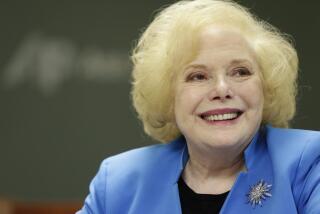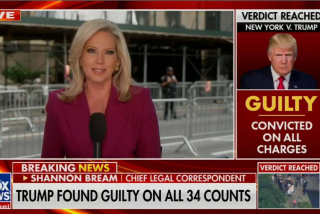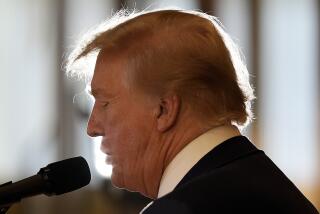Little for TV to Work With at Trial’s End
NEW YORK — Monday’s verdict in the Michael Jackson trial finally provided television with compelling audio and video to illustrate a case that had been kept behind closed doors.
But in the fiercely competitive world of television news, there were just a few exclusives. Court TV snagged a sit-down interview with prosecutor Tom Sneddon, and CNN’s Larry King spoke with jury foreman Paul Rodriguez.
The other networks also had ample footage of Sneddon, who spoke to the press after the verdict was read, along with the jurors, who held a group news conference to field questions.
Jackson, who did not give any interviews after the verdict, is bound to be highly courted by the media in coming days.
With cameras barred from the courtroom during the 14-week proceeding, broadcast and cable networks had been forced to depict the case through sketches, correspondent reports and legal analysis from experts. But on Monday, there were finally some pictures to show viewers -- and live sound from within the courtroom.
Shortly after 1 p.m. PDT, Fox News, CNN, Court TV and MSNBC began airing aerial images of a caravan of black SUVs leaving Jackson’s Neverland ranch and heading toward the courtroom in Santa Maria.
By 1:45 p.m., ABC, CBS and NBC had all broken into local programming with special reports. Within minutes, viewers glimpsed the pop star as he entered the courtroom. Shortly afterward, a media feed of the microphones in the courtroom was turned on for the verdict to be broadcast live. Still, with no video of the scene inside, TV reporters and producers had to rush out of the courtroom to describe the reaction inside.
“Well, I tell you, I’ve never seen a more glum-looking jury,” Greta Van Susteren said on Fox News.
Some television executives said the heated public debate that had already erupted about the verdict underscored the need to broadcast high-profile trials.
“What this does, perhaps more than any other recent case, is highlight the importance of cameras and the electronic press actually being in the courtroom,” said Henry Schleiff, president and chief executive of Court TV. “People would have understood this verdict better if they had been able to hear and see the testimony with their ears and eyes.”
Mark Effron, an MSNBC vice president, said that the absence of visuals affected viewership. “There was a great deal of interest in the trial, but I think it’s different when you can’t see the witnesses say what they’re saying.”
Two networks produced prime-time reports Monday on the case: NBC’s “Dateline” did an hourlong special on the effect on Jackson’s career; CBS’ “48 Hours” aired a 30-minute piece.
“48 Hours” used a graphic process on courtroom sketches to make them appear three-dimensional. “As creative people, we have to be focused on the editorial content,” said “48 Hours” executive producer Susan Zirinsky. “The pictures, they’re a gift.”
Given the competitive nature of the news divisions, there will still be an appetite to hear more from the players involved today, news executives said.
“I’m sure all the morning broadcasts will be going after these jurors like crazy,” said Marcy McGinnis, CBS’ senior vice president for news coverage.
More to Read
The biggest entertainment stories
Get our big stories about Hollywood, film, television, music, arts, culture and more right in your inbox as soon as they publish.
You may occasionally receive promotional content from the Los Angeles Times.










